MSI GE40 Review: a Slim Gaming Notebook
by Jarred Walton on July 16, 2013 3:00 AM ESTMSI GE40 Gaming Performance
Our notebook gaming suite is now set for 2013, and I'm toying with the addition of Company of Heroes 2 as a second RTS/strategy data point. We’re still collecting performance results for CoH2, however, so for now I’ll refer you to Mobile Bench for those numbers. Let's just say that the game can bring even powerful notebooks to their knees.
We’ve also got the GTX 680M courtesy of the Alienware M17x R4 in the gaming charts, along with the other notebooks from the previous page. Here are the charts, and please take the time to read the commentary before trying to draw too many conclusions as there’s more going on than may at first be apparent. We’ll start with the Value charts, where the CPU becomes even more of a factor, and then move on to the Mainstream charts.
Notebook “Value” Gaming Performance
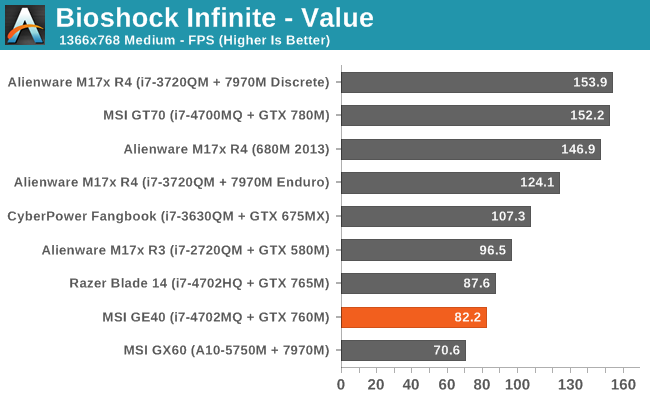
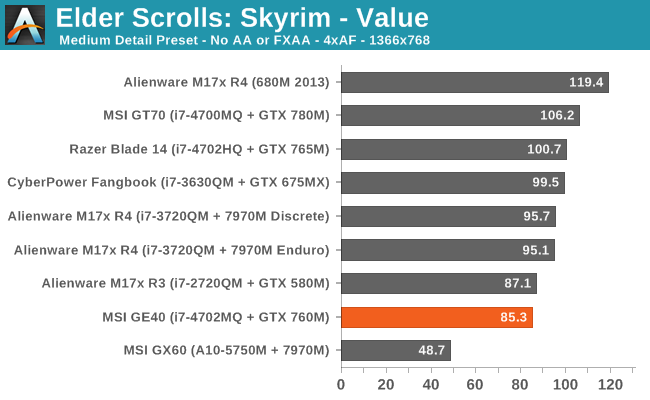
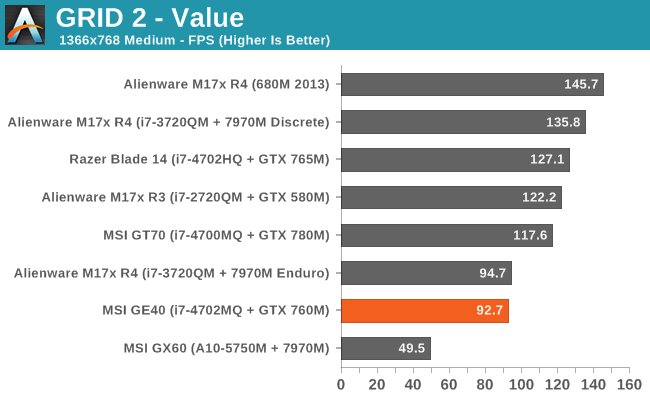
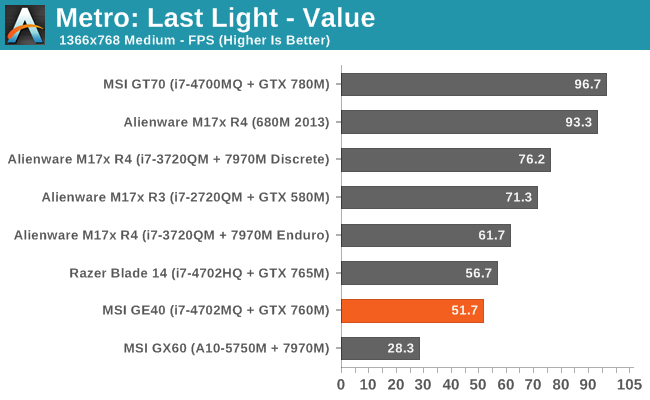
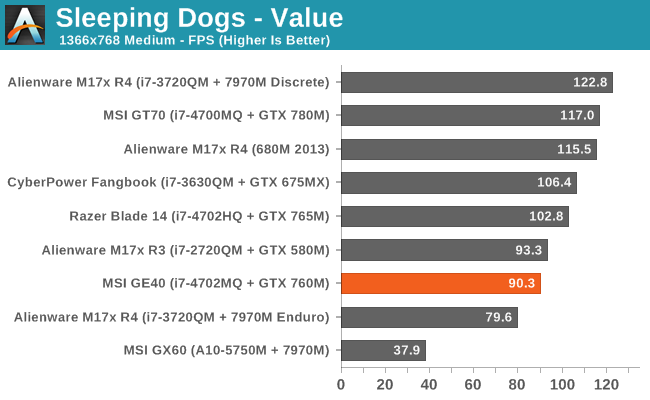
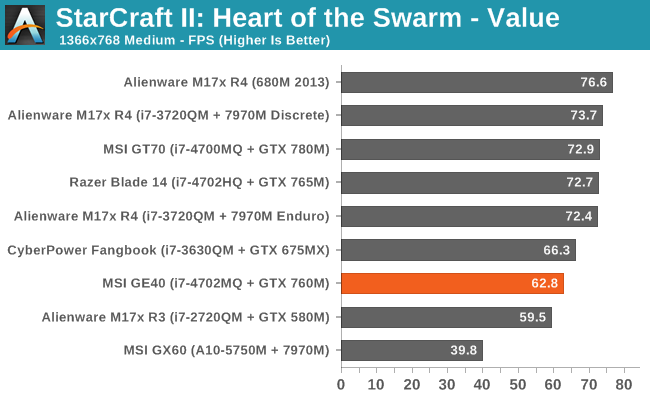
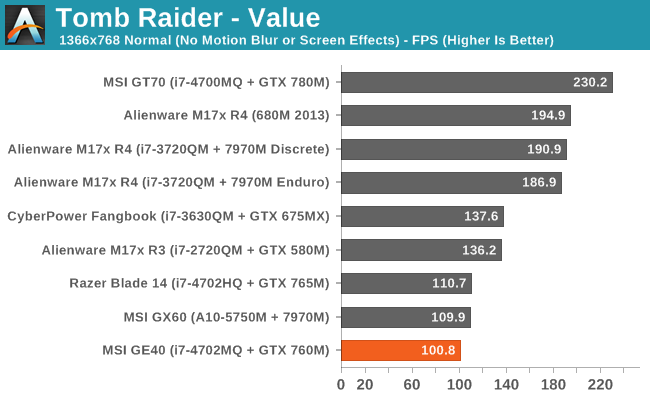
Notebook “Mainstream” Gaming Performance
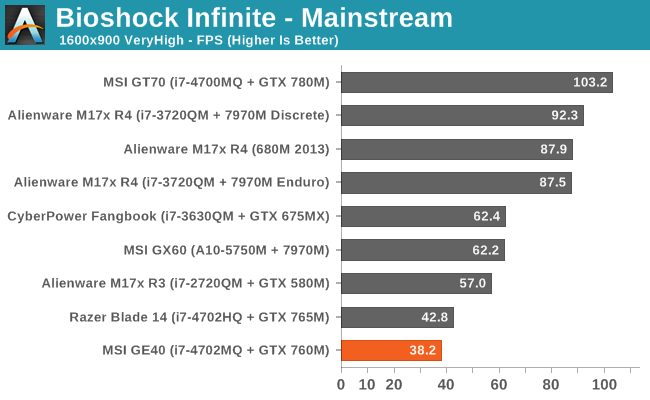

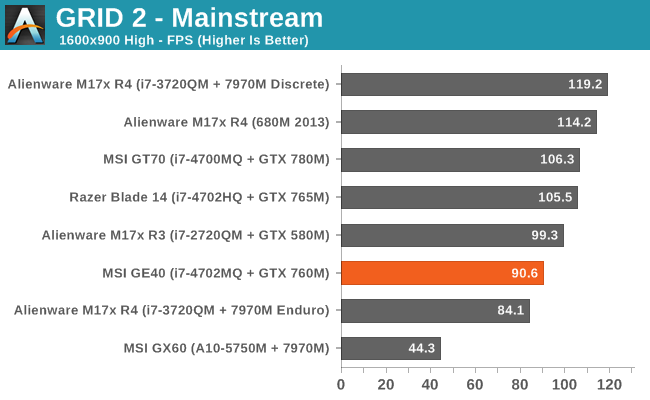
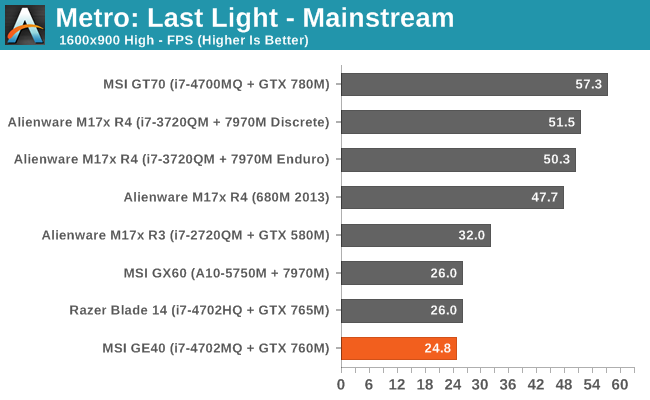
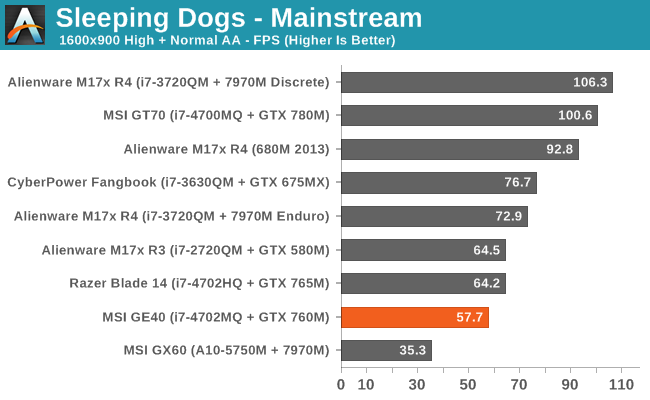
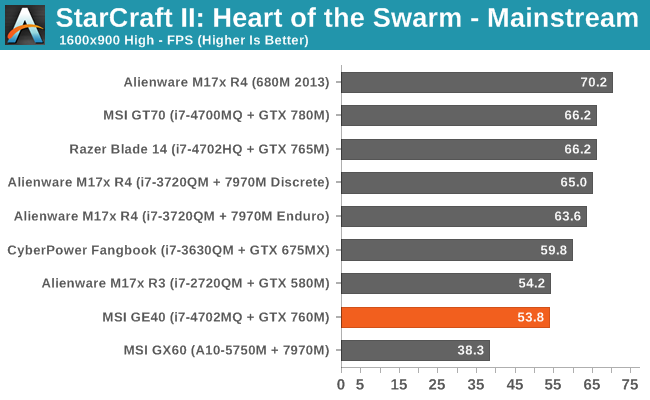
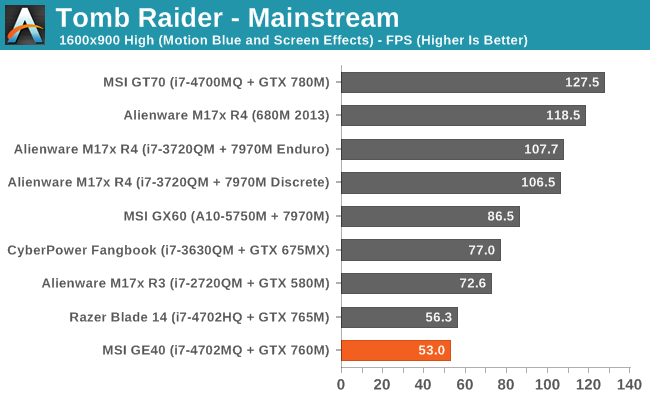
First, let me get this out of the way: the GTX 780M performance looks rather poor in many of these gaming benchmarks. The reason isn’t that our benchmarks are inherently flawed or even that the MSI GT70 is a “lemon”; rather, we’re looking at lower quality settings where the CPU plays a much greater role. We have another laptop (Clevo P157SM) with i7-4700MQ and GTX 780M, and while it’s sometimes up to 7% faster than the GT70, there are also instances where the GT70 wins by 5%; on average, our P157SM numbers average out to 0.01% faster at our Value settings and 1.3% faster at our Mainstream and Enthusiast settings.
The long and short of it is that the GTX 780M needs more CPU to really stretch its legs in some games; we’ll have a full review and investigation of CPU scaling with the GTX 780M in the future, but no matter how crazy it might seem, the results from our GT70 review aren’t far off of what you can expect in the games we’ve benchmarked at the settings we’ve used. Certain titles in particular are very CPU limited (Skyrim and StarCraft II), even at higher quality settings, and the i7-3820QM ends up being faster than the i7-4700MQ by a decent margin. (Note that the i7-4700MQ is really the replacement for the i7-3610QM, so the 3820QM is two steps above the 4700MQ.)
We can get a better idea of where the CPU matters most and where it matters least by looking at the performance of the MSI GX60. The HD 7970M is definitely faster than the GTX 760M and GTX 765M in most disciplines (e.g. look at the M17x 7970M discrete results; on average it’s 29%/41% faster than the 765M at Value/Mainstream and 50%/61% faster than the 760M), so when it loses—especially by a large margin—to the GE40, we’re looking at CPU bottlenecks. The only Value benchmark where the GX60 beats the GE40 is Tomb Raider; elsewhere it’s anywhere from 14% (Bioshock) to 58% (Sleeping Dogs) slower, and on average the GE40 runs through our Value suite 47% faster than the GX60! At the more demanding Mainstream settings, the gap narrows and the GX60 now claims wins in Bioshock, Metro: Last Light, and Tomb Raider; the GE40 is still 15% faster on average, with large wins in Skyrim, GRID 2, and Tomb Raider. It’s only at our Enthusiast settings that the GX60 starts to win in a majority of the games we’re testing. (Those scores aren’t shown here but they’re available in Bench—we figure with a 1600x900 panel and moderate GPU we didn’t need to show maxed out 1080p performance, but it’s still interesting to see how the GTX 760M handles those settings.)
Other than the GTX 780M “oddities”, the MSI GE40 places about where we’d expect. It’s always behind the Razer Blade 14, though again there appear to be cases where the Blade is hitting higher CPU turbo speeds. On paper the GTX 765M should at best provide 30% more performance than the GTX 760M (thanks to the higher core clocks). The average lead of the Razer Blade is 16% at our Value settings and 14% at our Mainstream settings, but the GRID 2 Value result is 37% faster on the Blade. Considering the increase in cost, though, that’s probably a performance tradeoff many would be willing to make.
Overall, the GE40 gets more than 60FPS in nearly every title we tested at 1366x768 Medium settings, and more than 30FPS at 1600x900 High settings. The one exception from our graphs: Metro: Last Light, where you can expect reasonable frame rates at 1600x900 Value settings but our Mainstream settings prove to be too much. Company of Heroes 2 is another brutal game, with Medium/Low 1366x768 settings getting a paltry 29FPS on the GE40 while the High/Medium 1600x900 results drop down to 23FPS. Hopefully a patch or new drivers will improve CoH2 performance—sooner rather than later—because right now the built-in benchmark can make even a GTX 780M struggle (e.g. 55FPS at our Value settings, 51FPS at Mainstream, and 23FPS at Enthusiast).










93 Comments
View All Comments
cooliend - Tuesday, July 16, 2013 - link
What about the Gigabyte P34G, which is expected to be released in August / September, and may start as low as $999?http://www.gigabyte.com/products/product-page.aspx...
Yes, it's one-to-two months away, but it pairs a 4700HQ with a 760M, in the same sub-1" thick package... with a 1080p display. Of course, it also shares the same, anemic 11.1v battery size...
superjim - Tuesday, July 16, 2013 - link
According to this youtube video the P34G will be 1080p non-IPS but the 15" P35 will be 1080p IPS (765MX). Either way, a 760M pushing native 1080p isn't going to fare well in most modern games.http://www.youtube.com/watch?v=iwQ-mHueK9U
cooliend - Saturday, July 20, 2013 - link
Agreed that 1080p is unlikely to be usable in newer games, but it should be usable for other tasks (older games, video, etc.) and it's always good to have options, especially cheaper ones!From the very limited youtube video hands-on looks at it, the screen is supposed to be fairly decent; hopefully it'll be better than those on the GE40 & Razer Blade.
IPS is nice, but only really addresses viewing angle washout and not a must-have for me. Image quality would be more important, and non-IPS can equal or better IPS panels in image quality - look at the Sony Z for great non-IPS displays (the Sony S13 screens however...).
mutumutu - Sunday, August 11, 2013 - link
According to Gigabyte site, P34G will have 14" FHD AHVA display, which is sort-of-IPS from AUO. Notebookcheck tested Clevo W740SU also with 14" FHD AHVA and it had excellent viewing angles and color reproduction although brightness and contrast were only decent.Bob Todd - Tuesday, July 16, 2013 - link
Thanks, hadn't seen that one yet. With what's currently possible in hardware, these are getting closer to an ideal machine for me (until integrated graphics can do 900p+ gaming @ high settings). I _really_ like the understated design of that one. I'm not saying it's beautiful, but compared to most gaming laptops it looks worlds better. Hopefully the non-IPS panel is of decent quality. Too bad about the tiny 47Wh battery though, that will be a deal breaker. Take the same design, throw in a high quality 3200x1800 panel (game at 1600x900), drop the vga for mini-DP, and put in a ~80Wh battery and I'm sold. I think we'll see something like that soon. At least I hope we will.Bob Todd - Tuesday, July 16, 2013 - link
Oh, and I don't mean to suggest they'd need to offer that for the same theoretical $999. The $1500+ range is fine.Krafty1 - Tuesday, July 16, 2013 - link
Once again...no Thunderbolt. These machines would make great travel video editing machines...if they would include some way to actually stream video into them. (You can convert Firewire to Thunderbolt)Better LCD, include Thunderbolt... I'll be ready to buy.
Freakie - Tuesday, July 16, 2013 - link
Streaming video from what? Many cameras just use USB for streaming because even USB 2.0 can handle most streams. Some older cameras do have firewire, it's true, but it can be kind of niche. But if you're oversaturating a USB stream then the camera usually comes with an Ethernet port anyways and the only time that happens really is if you're shooting 4k uncompressed. Kind of sounds like your gripe is more you just wanting something more than needing it?airmantharp - Tuesday, July 16, 2013 - link
Thunderbolt is for the storage array that you can't fit in the laptop :).cooliend - Saturday, July 20, 2013 - link
Better Thunderbolt (and Thunderbolt 2) usage is be external GPU's. Imagine these thin-and-lights sporting a decent 760m, so you can carry it around and game as you want (while plugged in), but then bumping it up to SLI 780s once you get home? Gigabyte's got Thunderbolt on the P35K, but unfortunately not the P34G...They just need to fix the inability of eGPU's to output to the laptop screen... though, then again, if you have a eGPU setup, you'd likely have a 21"+ monitor too.